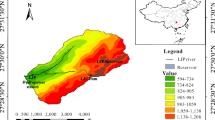Abstract
Rather than optimizing water regimes for one or a few species, a better approach is to approximate the natural flow regime that maintains the entire panoply of species. RVA method generally describes flow regimes through 32 hydrologic indicators, quantifies the changes of the indicators post-dam, and distinguishes the highly changed indicators. Based on this function, an ecological objective which takes natural flow regimes into consideration is established. The objective synthesize highly changed indicators selected from the 32 hydrologic indicators and minimize their degree of change to approximate the natural status. The function of the hydrologic indicators are quantified through fuzziology according to their effect on river environment when changed. The model is applied to Xiangyang section of the Han River downstream the Danjiangkou reservoir, which maximizes the ecological objective to close to a natural flow regime. By optimization, model results indicate that the maximum synthetical membership of the selected indicators is 0.5, which means that the post-regulation optimum release is 50 % closer to the natural flow regime. It is much better than the traditional power generation regulation model, the membership of which is only 0.2. The result indicates that the ecological model is better in improving the river ecosystem, but with reduced power generation because of excessive abandon water. However, when deeply evaluate the effect of the new model, it shows the possibility of a win-win scenario between maintaining ecosystem health and power generation.



Similar content being viewed by others
References
Gorman OT, Karr JR (1978) Habitat structure and stream fish communities. Ecology 59:507–515
Hassaballah K, Jonoski A et al (2012) Model-based optimization of downstream impact during filling of a new reservoir: case study of Mandaya/Roseires reservoirs on the Blue Nile River. Water Resour Manag 26:273–293
Koel TM, Sparks RE (2002) Historical patterns of river stage and fish commucities as criteria for oprations of dams on the Illiois River. River Research Application 18(1):3–19
Mei YD, Yang N, Zhai LN (2009) Ecological sound optimum operation of Operation of Cascade Reservoirs in lower Yalong River. Adv Water Sci 20(5):721–725
Ni JR, Cui SB, Li TH, Jin L (2002) On water demand of river ecosystem. J Hydraul Eng 9:14–19
Poff NL, Ward JV (1989) Implications of streamflow variability and predictability for lotic community structure: a regional analysis of stramflow patterns. Can J Aquat Sci 46:1805–1818
Poff NL, Allan JD, Bain MB, Karr JR, Prestegard BD, Richter BD, Sparks RE (1997) The natural flow regime: a paradigm for river conservation and restoration. Bioscience 47(11):22–29
Richter BD, Baumgartner JV et al (1996) A method for assessing hydrologic alteration within ecosystems. Conservat Biol 10(4):1163–1174
Richter BD, Baumgartner JV, Wigington R, Braun DP (1997) How much water does a river need? Freshwat Biol 37:231–249
Shiau JT, Wu FC (2004) Assessment of hydrologic alterations caused by Chi-Chi diversion weir in Chou-Shui Creek, Taiwan: opportunities for restoring natural flow conditions. River Res Appl 20:401–412
Shiau JT, Wu FC (2006) Compromise programming methodology for determining insteramflow under multiobjective water allocation criteria. J Am Water Resour Assoc 42(5):1179–1191
Sparks RE (1992) Risks of altering the hydrologic regime of large rivers. In: Cairns JB et al (eds) Predicting ecosystem risk. Advances in modern environmental toxicology. Princeton Scientific Publishing, Princeton, pp 119–152
Suen JP, Eheart JW (2006) Reservoir management to balance ecosystem and human needs: incorporating the paradigm of the ecological flow regime. Water Resour Res 42:W03417. doi:10.1029/2005WR004314
Yang N, Mei YD, Yin ZW (2010) Impact assessment of dams on the flow regime of lower river by improved RVA [J]. Resources and environment in Yangtze Basin 19(5):560–565
Acknowledgements
This research was supported financially by the National Natural Science Foundation of China (50779049) and the Priority Academic Program Development of Jiangsu Higher Education Institutions of China.
Author information
Authors and Affiliations
Corresponding author
Rights and permissions
About this article
Cite this article
Yang, N., Mei, Y. & Zhou, C. An Optimal Reservoir Operation Model Based on Ecological Requirement and Its Effect on Electricity Generation. Water Resour Manage 26, 4019–4028 (2012). https://doi.org/10.1007/s11269-012-0126-x
Received:
Accepted:
Published:
Issue Date:
DOI: https://doi.org/10.1007/s11269-012-0126-x




